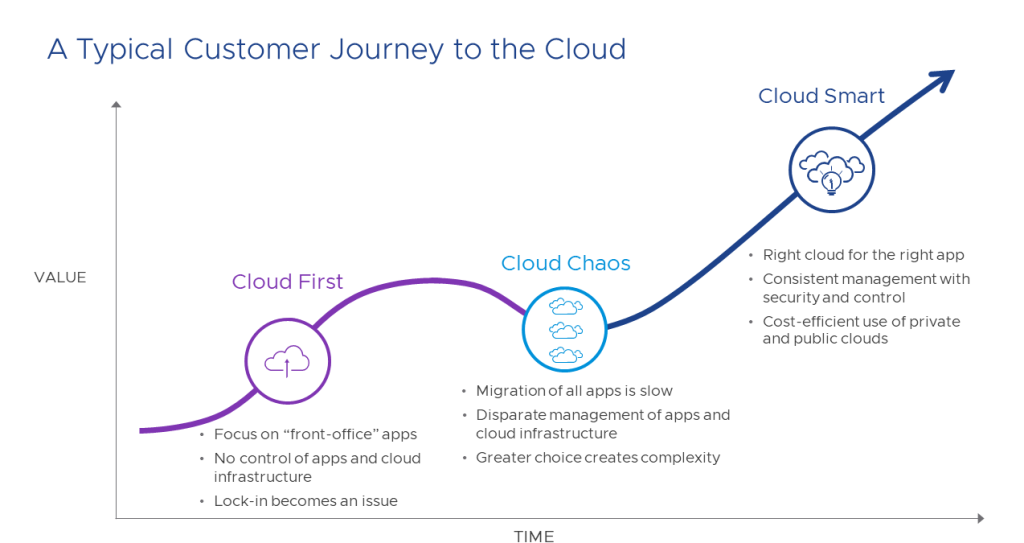10 Key Multicloud Strategies: Introduction
This content was written by Dave Rollins, Director of Technical Product Marketing for Cross-Cloud Services at VMware.
As VMware continues to educate customers about the multicloud problem and the benefits of VMware Cross-Cloud Services in their journey to cloud smart, one question is commonly asked, "How do I get started?". This blog series aims to provide guidance and review the top 10 areas for multicloud on where customers should focus. There will also be demos, tools and other resources to assist you. Before we jump into our first topic, let's review multicloud, Cross-Cloud Services, and the journey to Cloud Smart.
With 73% of enterprises using two or more clouds, having a multi-cloud strategy is critical to staying competitive. As companies have started leveraging multiple clouds, whether through M&A, the need for specific cloud-native services, or developer preference, it's led to siloed operations, increased costs, and tradeoffs between developer velocity and IT control.

Approximately a decade ago, as companies started to embrace the public cloud, the mindset was Cloud First. This phase's big focus was building customer-facing applications, typically in a single cloud. They started to see the benefits of modern app creation in the public cloud and the ability to get applications to market much faster, giving them a competitive edge. This first wave of cloud innovation drove massive advances in application innovation and velocity. However, controlling those applications and the underlying infrastructure proved difficult for most customers.
In a survey of VMware customers, many described their current state as "Cloud Chaos." Initially, the greater selection of cloud choices was of value for customers, but it ultimately led to a massive spike in complexity. Most report that building new apps is slow and cumbersome, and managing their entire app portfolio across disparate clouds is difficult and expensive. Each cloud requires an organization's team to use proprietary tools that are siloed and incompatible with other cloud providers. Meanwhile, getting fast, secure access to critical apps from anywhere is imperative for the average employee, yet it is often a challenge.
The desired destination of every multicloud journey is cloud smart. Being cloud smart means taking an architected and planned approach to multicloud and digital transformation. With a cloud-smart approach, you have the freedom to select the right cloud for the right application based on its needs. An overwhelming majority of companies taking a cloud smart approach say multicloud positively impacts their revenue, helps them retain and recruit top talent, and makes it easier to manage their data and extract value from it.
Now that we understand the problems customers are facing with multicloud, how do we solve them? The good news is that this is something VMware is great at, abstraction. Much like ESX, where we abstract the underlying hardware and can run virtual machines on disparate servers, we can apply the same concept to the multicloud problems across all the clouds. A set of services that can provide an abstraction layer where we need it and a single set of tools to manage the entire multicloud environment.

There are five key areas of abstraction:
- App Platform – By abstracting the application environment with Tanzu, we build any application for any cloud using whatever app framework developers are familiar with. This is all done in a repeatable, consistent and secure way.
- Cloud Management – From an operations or management perspective, abstracting this level with tools from Aria, we can deliver a multicloud operating model and provide visibility into cloud spend.
- Cloud and Edge Infrastructure – We can run any application on any cloud or edge location by abstracting the infrastructure layer and utilizing VMware Cloud.
- Security and Networking – When we abstract the Security and Networking layer with NSX and Carbon Black, we can provide consistent policies and guardrails regardless of the cloud.
- Anywhere Workspace – This provides anywhere, any device access with the best experience, all in a secure manner.

When you bring these all together, it creates this new layer of abstraction called VMware Cross-Cloud Services. This portfolio of cloud services delivers a unified and simplified way to build, operate, access and secure any application on any cloud.
We built the portfolio as an integrated solution, but each is independent, allowing customers to pick and choose the cloud services that deliver the most value to them based on where they are in their cloud journey. Customers are using a combination of these services to power these three transformations:
- How to rapidly develop and deploy applications;
- How to accelerate the transition to the cloud; and finally,
- How to empower their distributed workforce.
Now that we have reviewed the challenges most customers face with multicloud and how to solve them with VMware Cross-Cloud Services, we can start to answer the initial question, "How do I get started?" In this blog series, we will do just that. As the series progresses, this post will be updated with links to future posts.
The first topic we will cover in this series is assessing your organization, uncovering gaps, and recommending improvements using the VMware Multi-Cloud and App Maturity Model tool.